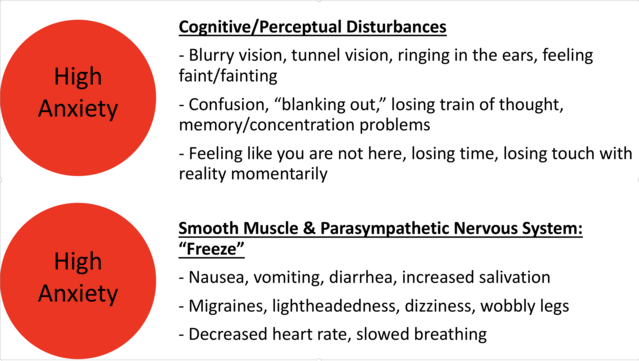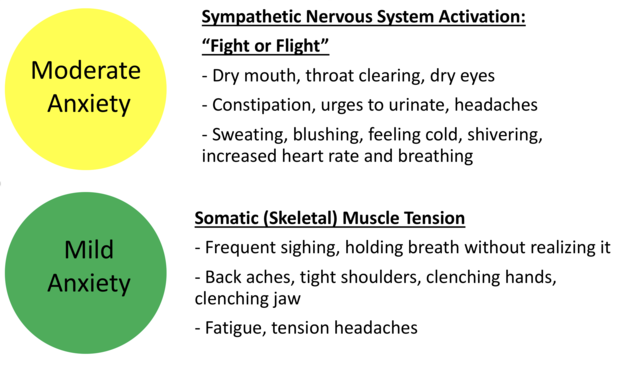Jane* is a 30-year-old woman with anxiety. She says she wants the thoughts to “go away” and she would prefer to not take medications. She’s tried a few things, including meditation, and says nothing works. She doesn’t know what to do.
To assist in situations like this, I often recommend going through a thought process that helps you identify the kinds of anxiety you experience so you can be fully aware of anxiety when it is happening and then take steps to manage it.
Question #1: “How do I experience anxiety? What am I thinking about when I am anxious and how do I feel that anxiety in my body physically?”
Here you are wanting to identify the thoughts as well as the physical symptoms of anxiety so that you can catch the anxiety quickly as it arises, not when it has taken over.
You may be someone who isn’t quite sure what you experience or how to describe it to someone else. All you know is that you feel uncomfortable or uneasy. You may say that the symptoms come “out of the blue” or that you know they are “triggered” by certain events, people, thoughts or situations. Conversely, you may be someone who knows exactly what you experience when you get anxious and can describe it well. Or, you may be somewhere in the middle.
Regardless of where you fall on that spectrum of awareness, it is possible that even if you are in tune with many of your anxiety symptoms, you might not be aware of all of them.
For today, I will focus on the physical signs of anxiety as many people have trouble identifying them and there are many blogs/articles that have already been dedicated to discussing how to identify/classify thoughts that often fuel anxiety (i.e., cognitive errors such as catastrophizing, black and white thinking, making comparisons, having extremely high expectations/perfectionism and so on).
Physical Signs of Anxiety
The graphics below list many symptoms of anxiety, broken down by severity. This is a good starting point to identify what it is you experience when you get anxious. (Please note that the symptoms described below are not always indicative of anxiety – a person could be dealing with a medical problem that is causing these symptoms as well. If a medical cause is suspected, a physician should be consulted.)


Question 2: “Which ‘zone’ am I in most of the time when I get anxious?”
- Green Zone – indicating mild anxiety
- Yellow Zone – indicating moderate anxiety
- Red Zone – indicating high anxiety
If you are in the Yellow or Red Zone frequently, it means that your nervous system is often in “Fight or Flight” (Yellow Zone) or “Freeze” (Red Zone), which is the human equivalent of a deer in the headlights. If this level of anxiety happens when you are in an important conversation or perhaps when you are working with your therapist, your nervous system likely will be too activated to safely process your emotions or make beneficial decisions. For this reason, it is critical that you are able to recognize these symptoms and do whatever you need to do to decrease your anxiety to the point that you are in the Green Zone or the anxiety symptoms go away completely.
Question 3: “What are my first signals of anxiety? Is it a thought? Is it physical? Is it a combination?” Said another way: “How do I know when I am getting anxious?”
Why does this matter? In most cases, anxiety progresses from the mild anxiety symptoms of the Green Zone up to higher levels of anxiety very quickly. If you are able to catch yourself sighing or clenching your jaw, for example, you likely can catch the anxiety faster before the symptoms flare and become more intense. Similarly, if you can catch those first few anxious thoughts, you can use mindfulness or other techniques to change your focus of attention and/or regulate your breathing.
Question 4: “What do I do when my anxiety jumps up into the Yellow or Red Zone? How do I calm my nervous system?”
When your anxiety reaches the Yellow or Red Zone, it is a good idea to do something to calm your nervous system down. There are many options to self-regulate anxiety, including deep/slow breathing techniques, the Relaxation Response by Dr. Benson, meditation, using the Four Steps, cognitive-behavioral techniques and so on. Another great resource for breathing techniques is Linda Esposito's Psychology Today blog: "3 Essential Exercises to Calm Anxiety"
Question 5: “What is my brain doing when I am anxious? Where am I focusing my attention?”
This question is aimed at helping you assess whether: 1) you try to reason away the thoughts – which inadvertently gives them more power and strength – and 2) what you are focusing on while you are anxious.
For example, you might be worried that something will happen in the future. When the anxiety hits, you might say, “Well, if A happens, then B will result. However, if C happens, then D will result. If I instead chose to do E, then F would happen.” Although you think you are figuring out all the possibilities so you are fully prepared for any eventuality, you are actually focusing more attention on the anxious thoughts, thereby making the brain pathways associated with those thoughts stronger.
If instead you:
- Identify the physical signs of anxiety (Step 1: Relabel)
- Remind yourself that this is nonsense brain “chatter” that is not reflective of who you are – “It’s not me, it’s just my brain” (Step 2: Reframe)
- Self-regulate with a few rounds of deep breathing, which allows you to focus your attention on breathing, rather than anxious thoughts (Step 3: Regulate and Refocus)
Then you take the power of your attention away from the anxiety. By choosing to Refocus your attention on anything that is beneficial to you (such as going for a walk, talking to a friend, work and so on), even if you still feel the physical anxiety, you begin to weaken the connection between the physical symptoms of anxiety and the thoughts. Over time, this results in strengthening brain pathways associated with healthy habits and weakening ones associated with anxiety.
Finally, if you have tried meditation and find that it doesn’t work for anxiety, ask yourself this question:
Question 6: “What kind of meditation do I do? Specifically, what am I doing with my brain/thoughts in meditation? Do I have an anchor for my meditation that I go back to whenever the thoughts pull me away?”
If you are not sure what you do with your brain/thoughts while meditating, it is possible that the meditation you are doing, while beneficial in other ways (such as for spiritual growth or calming) will not help you learn how to retrain your brain.
Ideally, for anxious, unhelpful thoughts, you want to identify an anchor (such as breath – the rise and fall of your chest or the feeling of the air going in and out of your nose) for your meditation session that helps bring you back into the present moment whenever you are pulled off by random brain-generated thoughts. The more you practice this form of meditation, the better you become at noticing your anxious thoughts and dismissing them when they arise. A good resource to practice this type of meditation is the "Complete Instructions" Mindful Meditations created by Diana Winston for the UCLA MARC Center.
By learning your specific anxiety signals (whether thoughts, physical sensations or both) and identifying how high the anxiety gets, you increase your ability to catch anxious thoughts or physical sensations as they arise. As your awareness increases, you have more opportunities to focus your attention on something that is beneficial to you, such as employing methods that help decrease Yellow/Red Zone anxiety (e.g., deep breathing, practicing the Four Steps, meditation, etc). This will help stop anxiety before it gets out of control and train the brain to strengthen pathways associated with healthy regulation and self-care skills.




